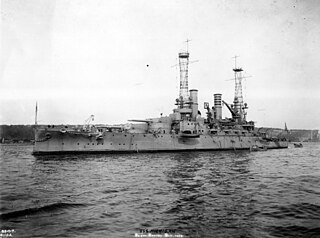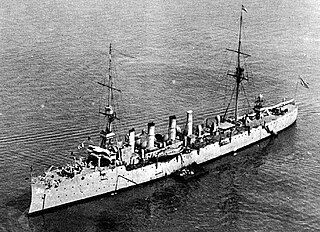
USS Florida (BB-30) was the lead ship of the Florida class of dreadnought battleships of the United States Navy. She had one sister ship, Utah. Florida was laid down at the New York Navy Yard in March 1909, launched in May 1910, and commissioned into the US Navy in September 1911. She was armed with a main battery of ten 12-inch (305 mm) guns and was very similar in design to the preceding Delaware-class battleships.

USS Michigan (BB-27), a South Carolina-class battleship, was the second ship of the United States Navy to be named in honor of the 26th state. She was the second member of her class, the first dreadnought battleships built for the US Navy. She was laid down in December 1906, launched in May 1908; sponsored by Mrs. F. W. Brooks, daughter of Secretary of the Navy Truman Newberry; and commissioned into the fleet 4 January 1910. Michigan and South Carolina were armed with a main battery of eight 12-inch (305 mm) guns in superfiring twin gun turrets; they were the first dreadnoughts to feature this arrangement.

USS Cole (DD-155) was a Wickes-class destroyer in the United States Navy during World War II, later reclassified as AG-116. It was named for Edward B. Cole, a United States Marine Corps officer who died as a result of the wounds he received at the Battle of Belleau Wood.

USS Kansas (BB-21) was a US Connecticut-class pre-dreadnought battleship, the fourth of six ships in the class. She was the second ship of the United States Navy named Kansas, but the only one named in honor of the state of Kansas. The ship was launched in August 1905 and commissioned into the fleet in April 1907. Kansas was armed with a main battery of four 12-inch (305 mm) guns and was capable of a top speed of 18 kn.

The second USS Pennsylvania (ACR/CA-4), also referred to as Armored Cruiser No. 4, and later renamed Pittsburgh, was a United States Navy armored cruiser, the lead ship of her class. She was originally assigned the name Nebraska but was renamed Pennsylvania on 7 March 1901.

USS South Carolina (BB-26), the lead ship of her class of dreadnought battleships, was the fourth ship of the United States Navy to be named in honor of the eighth state. She was also the first American dreadnought; though she did not incorporate turbine propulsion like HMS Dreadnought, South Carolina's design included revolutionary aspects as well, primarily the superfiring arrangement of her main battery. The ship was laid down in December 1906 and launched in July 1908 before being commissioned into the US Atlantic Fleet in March 1910.

USS Wyoming (BB-32) was the lead ship of her class of dreadnought battleships and was the third ship of the United States Navy named Wyoming, although she was only the second named in honor of the 44th state. Wyoming was laid down at the William Cramp & Sons in Philadelphia in February 1910, was launched in May 1911, and was completed in September 1912. She was armed with a main battery of twelve 12-inch (305 mm) guns and capable of a top speed of 20.5 kn.

USS Arkansas (BB-33) was a dreadnought battleship, the second member of the Wyoming class, built by the United States Navy. She was the third ship of the US Navy named in honor of the 25th state, and was built by the New York Shipbuilding Corporation. She was laid down in January 1910, launched in January 1911, and commissioned into the Navy in September 1912. Arkansas was armed with a main battery of twelve 12-inch (305 mm) guns and capable of a top speed of 20.5 knots.

USS Chester (CS-1/CL-1) of the United States Navy was the first scout cruiser (CS) built for the Navy. In 1920, she was reclassified as a light cruiser (CL). She was launched on 26 June 1907, by Bath Iron Works, Bath, Maine, sponsored by Miss D. W. Sproul, and commissioned on 25 April 1908. She was named in honor of Chester, Pennsylvania. In July 1928, long since decommissioned, her name was changed to USS York, in honor of York, Pennsylvania.

The first USS Minneapolis (C-13/CA-17) was a United States Navy Columbia-class protected cruiser. She was named for the city of Minneapolis, Minnesota.

The second USS Dale (DD-4) was a Bainbridge class destroyer in the United States Navy.

The USS St. Louis (C-20/CA-18), was the lead ship of her class of protected cruisers in the United States Navy. St. Louis was launched on 6 May 1905 by the Neafie & Levy Company, of Philadelphia, Pennsylvania. It was sponsored by Miss Gladys Bryant Smith and commissioned on 18 August 1906 with Captain Nathaniel R. Usher in command.

USS Galveston (C-17/PG-31/CL-19) was a Denver-class protected cruiser in the United States Navy during World War I. She was the first Navy ship named for the city of Galveston, Texas.

USS Tacoma (C-18/PG-32/CL-20) was a Denver-class protected cruiser in the United States Navy during World War I. She was the second Navy ship named for the city of Tacoma, Washington.

USS Salem (CS-3/CL-3), Scout Cruiser No. 3, was a Chester-class scout cruiser of the United States Navy. She was the first Navy ship named for the city of Salem, Massachusetts.

The fourth USS Columbia (C-12/CA-16) was a protected cruiser in the United States Navy during the Spanish–American War and World War I. She was the lead ship of her class of two cruisers; her sister ship was Minneapolis (C-13). The class was originally designed with three funnels; however, Columbia was built with four and Minneapolis with two. This may have been to make them resemble specific passenger liners.
USS Dallas (DD-199) was a Clemson-class destroyer in the United States Navy during World War II. She was the second ship named for Captain Alexander J. Dallas, and was later renamed Alexander Dallas.

USS Mississippi (BB-23) was the lead ship of the Mississippi class originally built by the US Navy in 1904–1908. The class was built to a design smaller than other American battleships as the result of a limit on displacement imposed by Congress as part of an effort to constrain costs. The ships were armed with a main battery of four 12 in (305 mm), the standard for pre-dreadnought battleships of the time, but to secure that heavy primary armament, significant compromises in speed, secondary batteries, and armor protection were necessary to keep the ship within the prescribed displacement limit.

USS Cincinnati (C-7) was a protected cruiser and the lead ship of the Cincinnati-class cruiser for the United States Navy. She was launched on 10 November 1892 by New York Navy Yard; sponsored by Miss S. Mosby; and commissioned on 16 June 1894, Captain Henry Glass in command. She was the second ship to be named after Cincinnati, Ohio.

The fourth HMS Volunteer (D71), later I71, was a Modified W-class destroyer of the British Royal Navy that saw service in World War II.




















